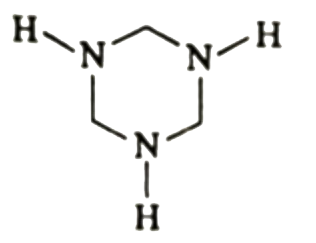Chloromethane on treatment with excess of ammonia yields mainly

N-Methylmethaneamine(CH3−NH−CH3)
methanamine(CH3NH2)
mixture containing all these in equal proportion
The correct Answer is:C
To solve the question, "Chloromethane on treatment with excess of ammonia yields mainly," we can follow these steps:
1. Identify the Reactants:
- The reactant we have is chloromethane, which is represented as CH₃Cl.
- The other reactant is ammonia, which is represented as NH₃. We are told that ammonia is in excess.
2. Understand the Reaction:
- Chloromethane (CH₃Cl) can react with ammonia (NH₃) in a nucleophilic substitution reaction. In this reaction, the chlorine atom in chloromethane is replaced by an amino group from ammonia.
3. Reaction Mechanism:
- The reaction can be represented as:
CH3Cl+NH3→CH3NH2+HCl
- Here, the chlorine atom (Cl) is replaced by an amine group (NH₂), resulting in the formation of methanamine (CH₃NH₂) and hydrochloric acid (HCl) as a byproduct.
4. Consider the Excess of Ammonia:
- Since ammonia is in excess, it will favor the formation of the primary amine, which is methanamine (CH₃NH₂). If ammonia were not in excess, we could potentially form secondary and tertiary amines as well, but that is not the case here.
5. Identify the Main Product:
- The main product formed from the reaction of chloromethane with excess ammonia is methanamine (CH₃NH₂).
6. Conclusion:
- Therefore, the answer to the question is that chloromethane on treatment with excess ammonia yields mainly methanamine (CH₃NH₂).
Final Answer:
The correct answer is methanamine (CH₃NH₂).
---
- The reactant we have is chloromethane, which is represented as CH₃Cl.
- The other reactant is ammonia, which is represented as NH₃. We are told that ammonia is in excess.
- Chloromethane (CH₃Cl) can react with ammonia (NH₃) in a nucleophilic substitution reaction. In this reaction, the chlorine atom in chloromethane is replaced by an amino group from ammonia.
- The reaction can be represented as:
CH3Cl+NH3→CH3NH2+HCl
- Here, the chlorine atom (Cl) is replaced by an amine group (NH₂), resulting in the formation of methanamine (CH₃NH₂) and hydrochloric acid (HCl) as a byproduct.
- Since ammonia is in excess, it will favor the formation of the primary amine, which is methanamine (CH₃NH₂). If ammonia were not in excess, we could potentially form secondary and tertiary amines as well, but that is not the case here.
- The main product formed from the reaction of chloromethane with excess ammonia is methanamine (CH₃NH₂).
- Therefore, the answer to the question is that chloromethane on treatment with excess ammonia yields mainly methanamine (CH₃NH₂).
The correct answer is methanamine (CH₃NH₂).
Topper's Solved these Questions
- GENERAL PRINCIPLE AND PROCESSES OF ISOLATION OF ELEMENTS BOOK - NCERT EXEMPLARCHAPTER - GENERAL PRINCIPLE AND PROCESSES OF ISOLATION OF ELEMENTS EXERCISE - General Principle And Processes Of Isolation Of Elements
55 Videos
- P-BLOCK ELEMENTSBOOK - NCERT EXEMPLARCHAPTER - P-BLOCK ELEMENTSEXERCISE - P-Block Elements
72 Videos
Similar Questions
Knowledge Check
Formaldehyde reacts with excess of ammonia to give
ACH2=NHB C
C DHexamethylenetetramine
DHexamethylenetetramineOne mole of diethyl ether on heating with conc. HI gives
Aethyl alcoholBEthaneCEthyl iodideDEthyleneGlycerol on treatment with excess HI gives
A1,2,3-triiodopropaneB1,3-diiodopropaneC2-iodopropaneD3-iodopropane
An halokane is made to treat with excess of alcholic ammonia to give mainly
View SolutionOxidation of ammonia yield
View SolutionOxidation of ammonia yield
View SolutionAniline on treatment with excess of bromine water gives
View SolutionAn haloalkane is made to react with excess of alcoholic ammonia to give mainly
View Solution
